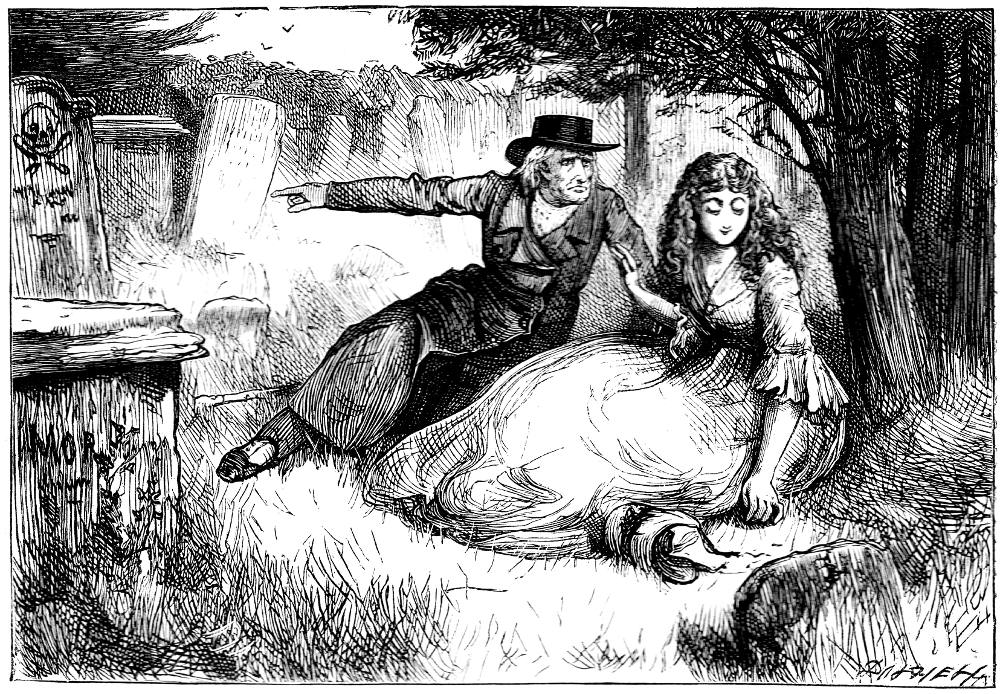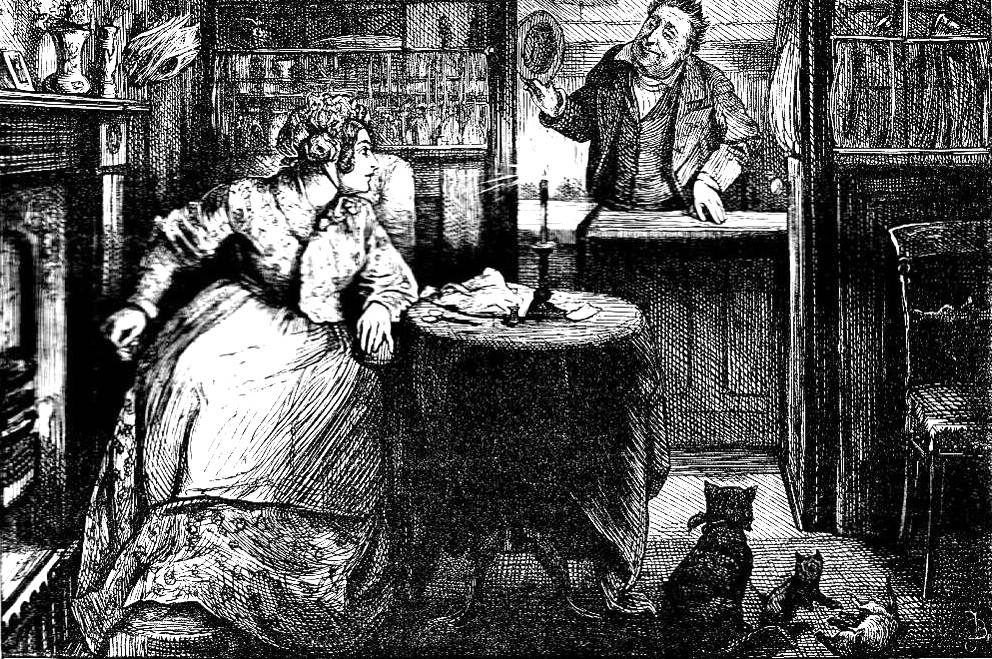
Old Martin and the Will by Harry Furniss in The Charles Dickens Library Edition (1910) — from Chapter 3, "In Which Certain Other Persons are Introduced; on the Same Terms as in the Last Chapter." (9.2 x 14.3 cm, framed) occupies its own page, facing VII, 33. [Click on the images to enlarge them.]
Passage Illustrated: Another Will Destroyed, and No Heir Named
He fell to trifling, as he ceased to speak, with the ashes of the burnt paper in the candlestick. He did so, at first, in pure abstraction, but they presently became the subject of his thoughts.
"Another will made and destroyed," he said, "nothing determined on, nothing done, and I might have died to-night! I plainly see to what foul uses all this money will be put at last," he cried, almost writhing in the bed; "after filling me with cares and miseries all my life, it will perpetuate discord and bad passions when I am dead. So it always is. What lawsuits grow out of the graves of rich men, every day; sowing perjury, hatred, and lies among near kindred, where there should be nothing but love! Heaven help us, we have much to answer for! Oh self, self, self! Every man for himself, and no creature for me!" [Chapter 3, "In Which Certain Other Persons are Introduced; on the Same Terms as in the Last Chapter," 44: the passages emphasized serve as Furniss's caption]
Commentary: The Irascible Old Martin Chuzzlewit
Furniss presents a striking representation of Old Martin's dilemma as he simply cannot determine which among his many predatory relatives is most deserving of inheriting his vast fortune. Old Martin here, however, bears little resemblance to the character drawn by Hablot Knight Browne in the 1843-44 serial and elaborated by seventies illustrator Fred Barnard in The Household Edition. The Furniss image, necessarily derivative, is rather more cartoon-like than Phiz's and certainly less realistic than Barnard's version of the canny senior in "Look about you," he said, pointing to the graves; "And remember that from your bridal hour to the day which sees you brought as low as these, and laid in such a bed, there will be no appeal against him" (see below: Chapter 24). The writing table, pen, and ink that Old Martin has just been using to draw up yet another will are conspicuously positioned in the illustration, which is Furniss's re-drafting of a similar illustration in the original serial. One of the strongest and most upright of Dickens's characters in the novel, Old Martin, attended by Mary Graham and wearing a scull-cap, appears in a place of prominence in the ornamental border for Furniss's title-page, Characters in the Story (upper left-hand corner). The portrait of Old Martin in his sick-bed at The Blue Dragon Inn (framed by bed-curtains, giving the scene a theatrical quality).
Over the course of a number of illustrated editions of The Life and Adventures of Martin Chuzzlewit (1844) a number of images of the novel's suspicious and secretive rich man, pursued by avaricious relatives and their hangers-on, Sol Eytinge, Jr. (1867 in the Diamond Edition), Fred Barnard (1872 in the transatlantic Household Edition), and Harry Furniss (1910). However, all of these are based on the original conception by Phiz, whose final illustration of him, as a stern Old Testament prophet, inspired by divine wrath, extirpating the devious Pecksniff, is perhaps the most compelling and dynamic. Despite the fact that the book bears his name and that his wealth is the mainspring of the action of the main plot, Old Martin is at best a minor character, rarely seen, so that, for example, American illustrator Felix Octavius Carr Darley elected not to depict him at all in the Sheldon and Company Household Edition volumes of 1863, and he was hardly worthy of visual comment by visual satirist Clayton J. Clarke (1910) in the Players' Cigarette Cards series. In the Household Edition (1872), the illustrator chose the arrival of the sanctimonious Pecksniff at the Blue Dragon as more worthy of visual comment in this same chapter.
In the background shadows stand Mary Graham (right) and Mrs. Lupin (left), but Furniss's twin focal points are the irascible old man's face and the destruction of the latest will in the candle flame, whereas Phiz's interest in January 1843 steel engraving Martin Chuzzlewit Suspects the Landlady Without Any Reason (see below) is evenly divided between the three figures because one of the functions of this early illustration is to introduce these characters to the reader. Although the suspicious Martin has already destroyed his latest draft in the 1910 plate, in Phiz's he is still writing, so that Phiz has placed the candle and the quill at the centre of the composition, whereas Furniss emphasizes the smoke from the burning document as he shows the old man, fully reclining on the bed, lamenting his failure to act. Although both plates contain a side-table, only the 1910 plate has the chair, just vacated by Mary, the old man's confidant and nurse. One certainly receives a better sense, too, of Old Martin's room at the inn in the Phiz illustration, which presents the occupant as an individual rather than, as in Furniss's plate, a type.
Related Materials: Background, Setting, Characterization
- Dickens's 1842 Reading Tour:
Launching the Copyright Question in Tempestuous Seas
- Dickens's Impressions of the Mississippi valley at Cairo, Illinois, the original of "Eden" in Martin Chuzzlewit
- A Bad Trip: The Trouble with Martin Chuzzlewit
- From Caricature to Progress: Master Humphery's Clock and Martin Chuzzlewit [chapter from Steig's Dickens and Phiz
- The critics and the characters in Martin Chuzzlewit
- The Names of Dickens's American Originals in Martin Chuzzlewit
- Seth Pecksniff, Architect
- The Divine Sairey Gamp: An Enduring Comic Masterpiece
- "Jolly" Mark Tapley in Martin Chuzzlewit — one of Dickens's most popular originals
- Dickens's Jonas in Martin Chuzzlewit and Milton's Satan
- Tom Pinch's love of bookstores
Other Programs of Illustration, 1843-1923
- Illustrations by Which to Read Martin Chuzzlewit: The Phiz Steels (1843-44) or the Barnard Woodcuts (1872)
- Illustrations by Phiz (Hablot K. Browne)
- Illustrations by Sol Eytinge, Jr. (1867)
- Illustrations by Fred Barnard (1872)
- Illustrations by Felix Octavius Carr Darley (1863)
- Illustrations by Kyd (Clayton J. Clarke) (1910)
- Illustrations by Harold Copping (1923)
Relevant Representations of Old Martin, 1843 to 1872



Left: Phiz's description of the same incident, Martin Chuzzlewit Suspects the Landlady Without Any Reason (Ch. 3, January 1843). Centre: Eytinge's compelling portrait of the suspicious old man, Old Martin and Mary (1867). Right: Phiz's description of the old man's climactic denunciation of Pecksniff, Warm Reception of Mr. Pecksniff by His Venerable Friend in the fiunal double number (Ch. 52, July 1844).

Above: Barnard's Old Martin's philosophizing about the consequences of poor choices made in youth, "Look about you," he said, pointing to the graves; "And remember that from your bridal hour to the day which sees you brought as low as these, and laid in such a bed, there will be no appeal against him" (Chapter 24, the Household Edition, 1872).

Above: Barnard's illustration of Old Martin's philosophizing about the consequences of poor choices made in youth, Pecksniff's saluting Mrs. Lupin in Chapter 3, Mr. Pecksniff looking sweetly over the half-door of the bar, and into the vista of snug privacy beyond, murmured "Good evening, Mrs. Lupin" (Chapter 3, the Household Edition, 1872).
Scanned images and text by Philip V. Allingham. [You may use these images without prior permission for any scholarly or educational purpose as long as you (1) credit the photographer and (2) link your document to this URL in a web document or cite the Victorian Web in a print one.]
Bibliography
Bentley, Nicolas, Michael Slater, and Nina Burgis. The Dickens Index. New York and Oxford: Oxford U. , 1990.
Dickens, Charles. The Life and Adventures of Martin Chuzzlewit. Illustrated by Hablot Knight Browne. London: Chapman and Hall, 1844.
__________. Martin Chuzzlewit. Works of Charles Dickens. Household Edition. 55 vols. Illustrated by F. O. C. Darley and John Gilbert. New York: Sheldon and Co., 1863. Vols. 1 to 4.
__________. The Life and Adventures of Martin Chuzzlewit. Illustrated by Sol Eytinge, Junior. The Diamond Edition. Boston: Ticknor and Fields, 1867.
__________. The Life and Adventures of Martin Chuzzlewit. Illustrated by Fred Barnard. The Household Edition. 22 vols. London: Chapman and Hall, 1872. Vol. 2.
__________. Life and Adventures of Martin Chuzzlewit. Illustrated by Harry Furniss. The Charles Dickens Library Edition. 18 vols. London: Educational Book, 1910. Vol. 7.
Guerard, Albert J. "Martin Chuzzlewit: The Novel as Comic Entertainment." The Triumph of the Novel: Dickens, Dostoevsky, Faulkner. Chicago & London: U. Chicago , 1976, 235-60.
Hammerton, J. A. Ch. 15, "Martin Chuzzlewit." The Dickens Picture-Book: A Record of the Dickens Illustrations with 600 Illustrations and a Frontispiece by Harry Furniss. The Charles Dickens Library Edition. 18 vois. London: Educational Book, 1910. XVII, 266-93.
Steig, Michael. "III. From Caricature to Progress: Master Humphrey's Clock and Martin Chuzzlewit." Dickens and Phiz. Bloomington & London: Indiana U. , 1978, 51-85.
__________. "Martin Chuzzlewit's Progress by Dickens and Phiz." Dickens Studies Annual 2 (1972): 119-49.
Vann, J. Don. Victorian Novels in Serial. New York: Modern Language Association, 1985.
Created 21 January 2016
Last modified 17 January 2020